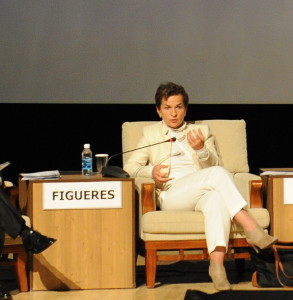
Christopher Rapley, Professor of Climate Science at University College London (UCL), said the 2013 IPCC report is “arguably the most rigorous scientific report on anything ever.” It shows that “there is absolutely no doubt that the world is warming.” And it finds that the degree of certainty that the warming is man-made has moved up to 95%. The report, Climate Change 2013: the Physical Science Basis, “isn’t a run-of-the-mill report to be dumped in a filing cabinet,” said Rapley, who was not involved with the report. “It’s not a political document. It’s science.” So why isn’t there greater commitment to changing the energy mix? The issue arouses “strong emotions,” Rapley observed. “It is an inconvenient truth.” To try to deal with that, climate scientists “tend to be very conservative,” fearing that otherwise they’ll sound “alarmist.” What’s the one best solution? “Make CO2 smell bad,” he suggested, and then no one will live next to a coal mine, no one will like driving a car.
“All the planet cares about is how much CO2 is in the atmosphere,” Rapley said. “There’s only so much carbon we can yet burn.” The maximum, he said, is 800-880 gigatons. If more than that is burned, that risk rises of global warming growing by more than 2°C rise, which, scientists believe, is the optimum level. “At the rate that we’re burning it now, we will have used it all in the next 30 years,” Rapley said. “If we continue at business as usual, we could well be at three or four degrees at the end of this century, and rising.”
The electricity industry, said Philippe Joubert, Executive Chair of WEC’s Global Electricity Initiative (GEI), “can do a lot. We know how to decarbonize electricity.” To stop emitting CO2, “nuclear is part of the solution.” So is renewable non-CO2 technology. “They all have their limits,” Joubert said. “We still have some difficulty to deal with intermittency. We have all the technology. After that we’ll use the CCS” - carbon capture storage - because the world will still be using fossil fuels for a long time.
Electricity storage is the only vital technology that doesn’t yet exist, Joubert said. “R&D doesn’t go by an act of God,” he explained. “The signals from the public and the regulators are not clear. To make this kind of decision we have to give the industry a long-term, stable direction.” Convince the industry that the public and government want it and industry will do it. “As long as you play around with CO2 price - $5, then $30, then back to $5 - we will not be safe to invest seriously in new CO2 technology.”
Khalid Abuleif, Chief Climate Agreements Negotiator for the Saudi’s Ministry of Petroleum and Mineral Resources, emphasized the need for equity in finding solutions to global warning when “1.3 billion people in the world do not have access to electricity.”
This news story is based on the session Game Changer, “Climate negotiations: How to bridge the three gaps?”, at the 2013 World Energy Congress.





